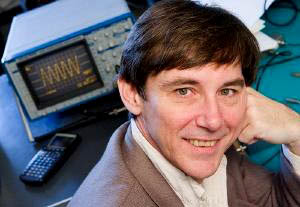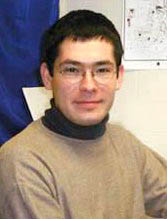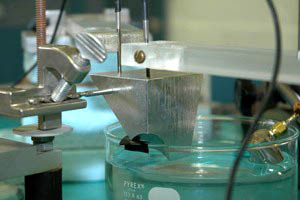The ultrasound equivalent of a laser could lead to important new discoveries in materials science by providing researchers with a non-destructive way to detect even the subtlest of changes, such as phase transitions, deep in their samples. Now, researchers at the University of Illinois at Urbana-Champaign and at the University of Missouri-Rolla have built just such an ultrasound analogue of the laser – the uaser, pronounced way-zer.
Light amplification by stimulated emission of radiation devices, lasers, are well known, but a sonic analogue had until now not been developed. Richard Weaver and his colleagues set out to change that and to develop a device that would induce ultrasound amplification by stimulated emission of radiation to produce coherent ultrasonic waves of a single frequency. A sonic laser has been possible for some time now, Weaver told us, our method could have been done earlier. I tend to think it wasn’t for two reasons: first no-one saw an application and second few people are expert at both laser physics and ultrasonics.

Richard Weaver
Ultrasound penetrates solids without harmful ionizing radiation and researchers have been using it for many years to find cracks, assess material damage or material microstructure, and to look inside the human body. Conventional methods for making ultrasound are already well developed and are better for such applications. However it is in the field of conventional light lasers that the uaser might be used most effectively to study laser activity itself.
“We have demonstrated that the essential nature of a laser can be mimicked by classical mechanics – not quantum mechanics – in sound instead of light,” explains Weaver.

Alexey Yamilov
To make their uaser, Weaver, Illinois research associate Oleg Lobkis and UMR physics professor Alexey Yamilov mounted several piezoelectric auto-oscillators on to a block of aluminium. This would serve as an elastic, acoustic body. When they then apply an external acoustic source to the body, the oscillators do their thing and synchronize their oscillations to its tone. When the external source is switched off, the tiny ultrasonic transducers lock on to each other because they are connected to the same acoustic body, almost like stringing a guitar with six G strings and plucking just one, the other five would oscillate in unity with the same frequency. We exploit the fact that coherence and stimulated emission are classical concepts and, as such, can be applied to build a mechanical device, explains Yamilov.

An aluminium block interacts with electronic oscillators through piezoelectric transducers to make a sound laser.
By careful design of the transducers, the team can ensure that they all oscillate in phase, something that would be tantamount to plucking all six G strings at exactly the same time. “We can assure the correct phases and produce stimulated emission, Weaver explains, As a result, the power output scales with the square of the number of oscillators.”
The current design of uaser more closely resembles a “random laser” than it does a conventional, highly directional laser, Weaver concedes, “In principle, however, there is no reason why we shouldn’t be able to design a uaser to generate a narrow, highly directional beam.”
Nevertheless, uasers may be useful. With their longer wavelengths and more convenient frequencies, uasers could prove useful for modelling and studying laser dynamics. They could also serve as highly sensitive scientific tools for measuring the elastic properties and phase changes of modern materials, such as thin films or high-temperature superconductors.
“Uasers can produce an ultrasonic version of acoustical feedback – an ultrasonic howl similar to the squeal created when a microphone is placed too close to a speaker,” Weaver adds, “By slowly changing the temperature while monitoring the ultrasonic feedback frequency, we could precisely measure the phase change in various materials.”
Further reading
Alexey Yamilov
http://web.mst.edu/~yamilov/
Richard Weaver
http://physics.illinois.edu/people/profile.asp?r-weaver
Suggested searches
lasers
ultrasonics